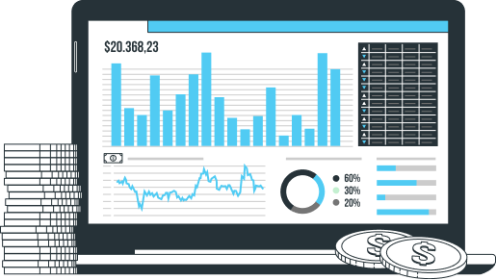For years and years, SEO and SEA experts have practically been at each other’s throats. You have no doubt heard before the (all too) familiar saying that claims the one always cannibalizes traffic from the other. Let’s explore why SEO and SEA are so often considered at odds…
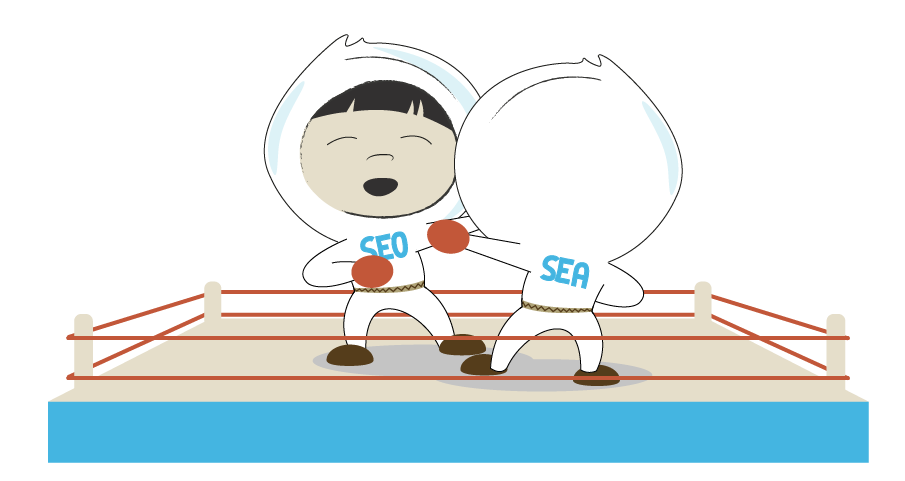
Stop Seeing SEO and SEA as Adversaries
How many times have I heard a web marketer use the following arguments to defend their work:
“Google Analytics selects the most recent acquisition channel as the only one responsible for conversion. If a client first finds you through SEA, but SEO is the reason they come back to make a purchase a week later, then the ROI will be wrongly attributed to SEO. The true conversion channel should actually be SEA, and yet no one will ever know.”
- Note that the example works both ways.
If you’re having a hard time grasping how these two main levers of traffic acquisition – which are SEO and SEA – complement each other, my hope is that this article will help you all reach the conclusion that, within any digital marketing strategy worth its salt, one cannot survive without the other.
The Truth Is in the Numbers: Eye Tracking Study
In order to compare AdWords ads with organic results, let’s take a look at where our eyes focus once we start a search. The intrinsic difference between SEA and SEO (Search Engine Optimization) can be misleading. You will notice an SEO/PPC synergy that one might not originally suspect.
A Past and Present Look at the Golden Triangle
For starters, the Golden Triangle shows that our eyes invariably focus on the top-left section, right where the Organic Top 3 and PPC ads are located.
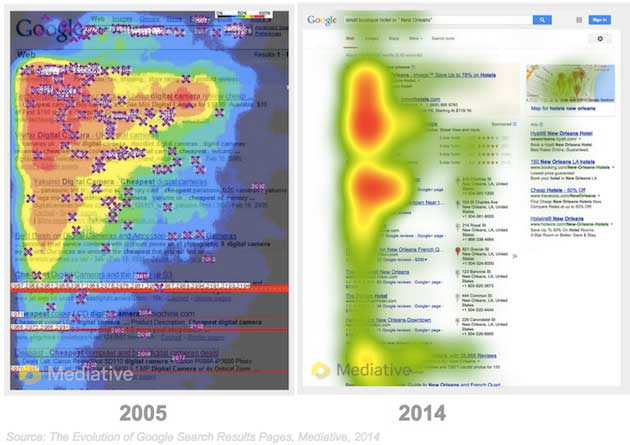
Note that, depending on the number of PPC ads being offered, the figures are different:
- If a single Google ad shows up, the user is more likely to click on the organic result.
- If three PPC ads show up, then they will favour those over the organic results.
Between 2005 and 2014, the Golden Triangle evolved to take on a more transverse shape. The changes brought on by mobile traffic – which follows a scroll-up/scroll-down model – have certainly had their own influence on the matter.
Evolution of Organic Clicks and CPC Campaigns
Let us see how organic clicks have evolved when compared to other elements from the SERPs (including AdWords Ads) through the following outline:
- Rank 1 = 32.3% in 2005, vs. 32.8% in 2014
What we learn: We can observe a slight progression.
- Ranks 2 to 4 = 47.8% in 2005, vs. 62.6% in 2014
What we learn: We can observe a clear increase in organic clicks.
- Ranks 4 to 10 = 67.6% in 2005, vs. 84% in 2014
What we learn: We can also observe a clear increase in organic clicks.
To sum up, competition between the first position in organic results and PPC campaigns remains substantial, yet stable, despite a slight, 0.5% increase in favour of SEO. This also implies that by hogging Position 1 in the organic results all while implementing a PPC campaign, one can achieve exponential visibility. There is a true SEO and PPC synergy at play here.
On the other hand, from ranks 2 to 10, organic results become more significant over the years, making things complicated for PPC Ads to stand out as soon as the user starts to lower their eyes.
- A special mention to those who won’t stop saying that our dear friend Google favours AdWords in the SERPs
The Impact of Organic Search [SEO] On Paid Search [SEA]
When SEO experts rework the architecture and semantics of a website’s pages, they make it easier for Google to understand its contents. Thus, this also improves the consistency of PPC campaigns, since the keywords targeted in the ads will be found in the optimized content as well. This is another way the SEO and PPC synergy makes up for the difference between SEA and SEO.
- SEO architecture is often a mirror of AdWords ads architecture.
SEO and SEA can be viewed as working hand in hand, as On-Site SEO is directly connected to the progress of Google ads’ Quality Score. It strengthens their positioning, increases their CTR, and brings down costs, thus boosting ROI.
It’s worth noting that pages with pleasing ergonomics are likely to improve customer satisfaction, which never fails to add to the relevance of the landing pages selected for PPC campaigns.
The Impact of Paid Search [SEA] On Organic Search [SEO]
Another point that often arises in the SEO/SEA battle is the fact that it takes six months to implement search engine optimization (SEO) correctly. This channel – which offers a medium to long-term action – therefore needs to be supported, and its role passed on to paid referencing (SEA) in the short term. It’s true that there is nothing quite like a good AdWords campaign to breathe life into a website as soon as it launches. Such an approach is a great way to start a strategy to gain visibility on Google off on the right foot.
When a site launches, Google needs indicators in order to assess the relevance of its pages. The traffic generated by SEA will give it a basis on which to analyze the user experience. This will send positive signals to the search engine.
An SEA strategy is also a great way to gather sensitive data relating to the volume and relevance of the keywords. This type of information is all the more crucial that Google isn’t keen on giving it up easily, preferring Google Analytics’s “not provided” instead.
Lastly, the American giant grants a lot of credit, and ultimately better rankings, to websites with a solid reputation. This means that any search engine marketing (SEM)/advertising strategy will have an indirect impact on SEO. By increasing brand awareness, you automatically improve branding and direct traffic.
What Is the Best Strategy to Build Between SEO and SEA?
SEO &SEA: Two Levers, Two Strategies
One often hears the following question: “I don’t know which acquisition channel to begin with, which is best?”.
It’s worth mentioning that many fall into the trap of wanting to compare two channels (SEO and SEA) that subscribe to entirely different strategies:
- With SEA, the idea is to launch a search engine advertising campaign and to purchase traffic.
- With SEO, the goal is to launch a strategy based on popularity with search engines like Google, therefore targeting the website’s reputation and positioning.
Sure, an AdWords campaign is more appropriate in the context of short-term advertising, to communicate around an event, for instance. With that said, we’re assuming that the website in question is looking to implement a global web strategy to achieve better visibility with search engines in the long term.
SEO + SEA: An Incremental Strategy, Not a Cannibalistic One!
A study carried out by Google in 2011 revealed that 89% of clicks on PPC ads (AdWords) complement organic clicks. This very much conveys the notion that traffic increases incrementally: Users who click on PPC campaign links are not the same as those who click on organic results. This means that the difference between SEA and SEO can be used to your advantage.
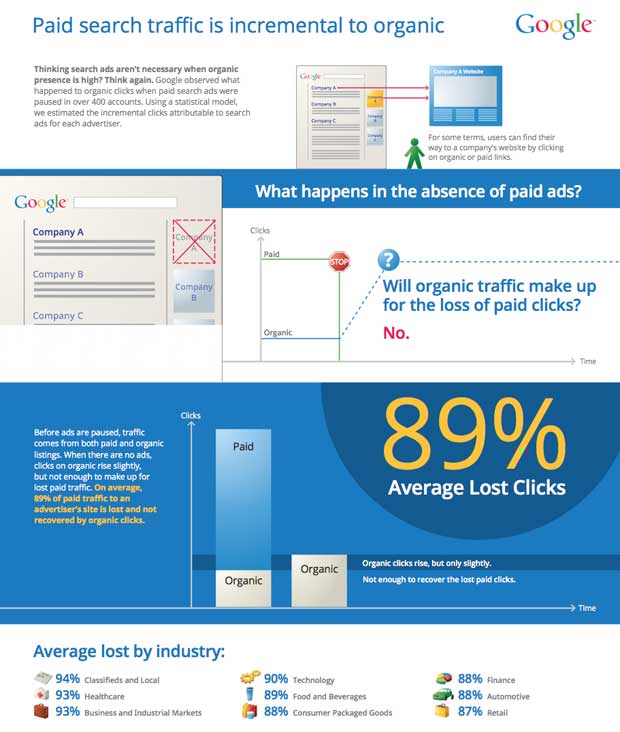
Still, the figures diverge based on the website’s organic positioning. In the case of a top ranking in the SERPs (Search Engine Result Pages), it is estimated that clicks on SEO and SEA results average 50%. In that situation, it is not inaccurate to consider it semi-cannibalism.
Yet, as soon as one goes any lower than the first organic position, the rate shoots back up to over 80%, which consolidates the idea that both channels complement each other optimally.
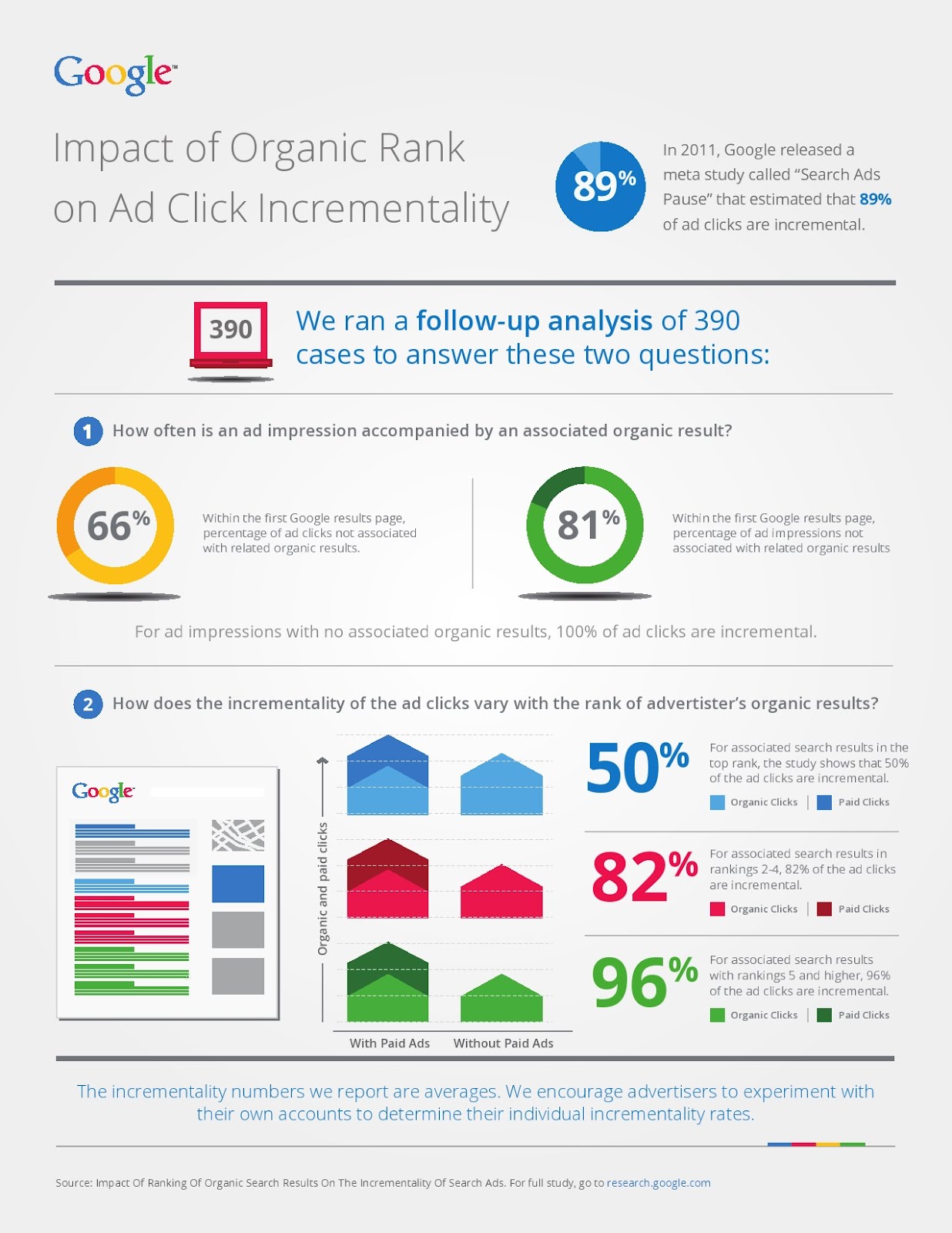
The Impact of Social Media Optimization [SMO] On Organic Search [SEO]
Social media optimization (SMO) is identical to SEA and to any other strategy that relies on branding, especially newsletter campaigns, since these contribute to building a brand’s reputation. Many visitors will indeed come back to the website via search engines, thus indirectly improving your long-term optimization.
Conclusion
The answer is a resounding yes: SEO and SEA do work together and are profoundly complementary in every way. A study carried out by Enquiro in 2005 (Eye Tracking Study) exemplifies the fact that these two channels can be used at the same time very successfully, and the results are compelling:
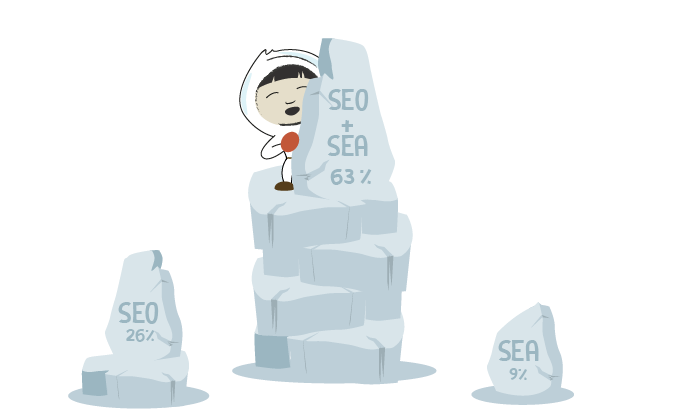
- A good SEA strategy reaches 9% of all visitors on average
- A good SEO strategy reaches 26% of all visitors on average
- A good strategy that combines SEO and SEA reaches 63% of all visitors on average.









